Wyoming is a state that is widely known for its stunning mountains and vast open prairies. However, it is also known for its animals – including bison, wolves, bears, and wild horses. However, snakes are also pretty abundant in the state, with fifteen native species – including two that are venomous. Therefore, if you’re out exploring, then it’s important to be able to identify any snakes that you see. So, let’s learn about the black snakes in Wyoming!
1. Desert Striped Whipsnake (Masticophis taeniatus taeniatus)
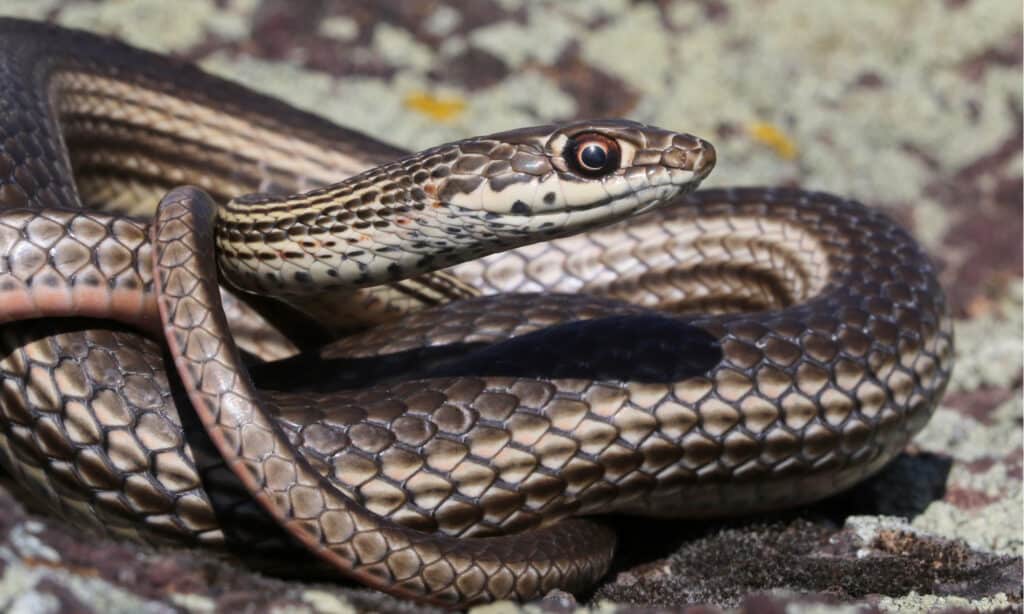
Desert striped whipsnakes live in scrublands, woodlands, and rocky outcrops in Wyoming.
©Randy Bjorklund/Shutterstock.com
We’ll begin with a subspecies of the striped whipsnake – the desert striped whipsnake. These snakes reach around 65 inches and have black, gray, or brown bodies with cream or yellow stripes. They also have broad heads with slender necks. Desert-striped whipsnakes are agile snakes with excellent eyesight, often scanning the surrounding area with their head held up above the ground as they search for prey. They are not venomous, and their diet mainly consists of lizards, small mammals, and insects. Desert striped whipsnakes live in scrublands, woodlands, rocky outcrops, and at the bottom of canyons in Wyoming. However, they only occur in the far southwestern region of the state – near the southern part of Flaming Gorge. They are mainly active between April and October and then overwinter in crevices between rocks.
2. Bullsnake (Pituophis catenifer sayi)

The bullsnake is the longest snake in Wyoming.
©Markparker1983/Shutterstock.com
The longest snake in Wyoming is the bullsnake which reaches 36 to 72 inches long. Bullsnakes are a subspecies of the gopher snake. These snakes have yellow bodies with dark brown or black blotches. They are fairly widespread across Wyoming and live in a range of habitats – such as grasslands, forests, plains, and prairies. However, they most often occur in areas with high rodent populations, as rodents make up a large portion of their diet. Bullsnakes are not venomous, but they can sometimes be mistaken for rattlesnakes as they have a habit of vibrating their tail in the leaf litter when they are threatened. They also raise themselves up off the ground to make themselves look larger and more intimidating to predators. Bullsnakes can also be aggressive and tend to lunge violently at the threat while still managing to retreat.
3. Great Basin Gopher Snake (Pituophis catenifer deserticola)
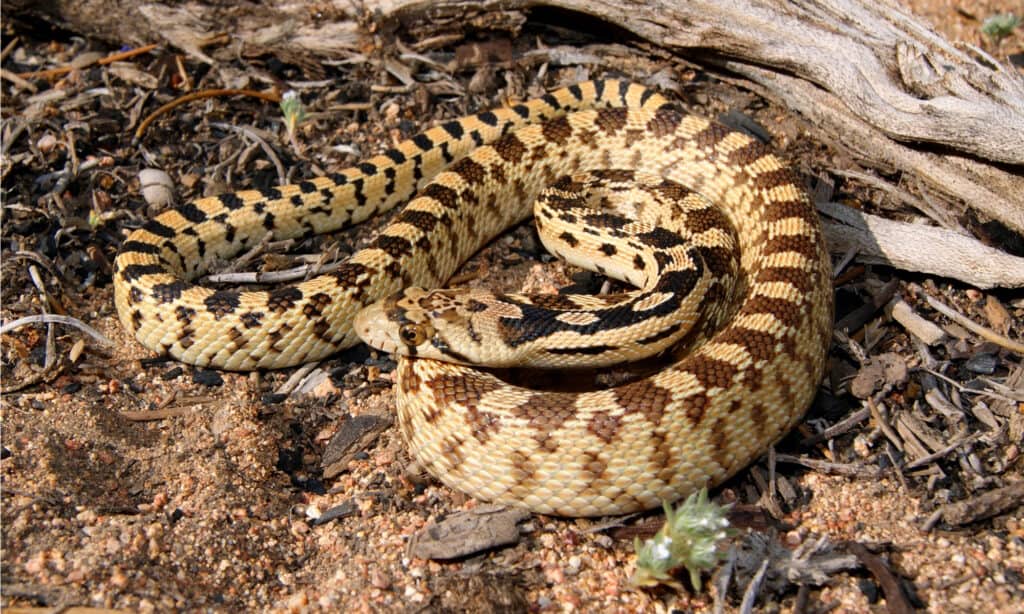
Great Basin gopher snakes live in deserts and plains where there is plenty of loose soil.
©Matt Jeppson/Shutterstock.com
The next black snake in Wyoming is another gopher snake subspecies – the Great Basin gopher snake. This snake is around 54 inches long and has a yellowish-brown body with black and dark brown spots connected by thin lines. Like the bullsnake, this snake can often be mistaken for a rattlesnake due to the way that it hisses and vibrates its tail when disturbed. In Wyoming, Great Basin gopher snakes live in deserts and plains where there is plenty of loose soil. However, they are only found in the south-central counties at low elevations and west of the Continental Divide in the Wyoming Basin. Great Basin gopher snakes prey on birds, lizards, and small mammals – particularly pocket gophers.
4. Plains Black-Headed Snake (Tantilla nigriceps)
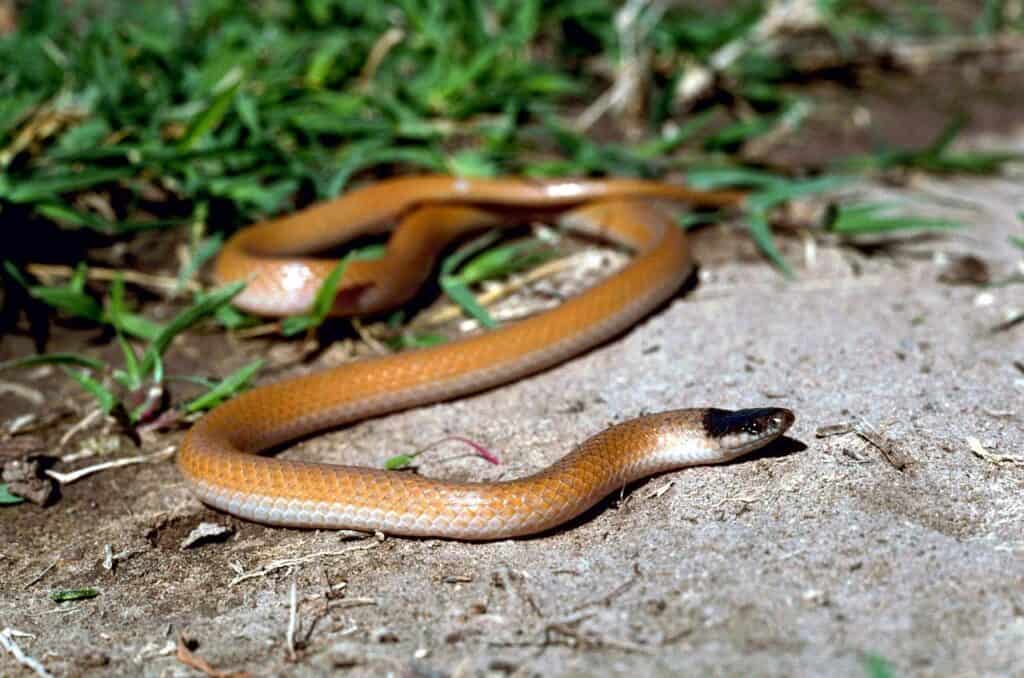
Plains black-headed snake is highly secretive.
©Gary M. Stolz, U.S. Fish and Wildlife Service / public domain – License
The plains black-headed snake is a small snake that reaches only 7 to 15 inches long. Plains black-headed snakes have slender tan bodies with distinctive black heads. They live in grasslands, prairies, and woodlands where there is moist, loose soil. These snakes are highly secretive and prefer to remain hidden away underground or underneath the leaf litter. Plains black-headed snakes mainly forage for food during the night after heavy rainfall, with their preferred diet consisting of insects and earthworms. They are fairly rare in Wyoming and only occur in Carbon and Platte counties.
5. Red-Bellied Snake (Storeria occipitomaculata)

Red-bellied black snakes are glossy black on the top and various shades of red on their underside.
©Ken Griffiths/Shutterstock.com
As their name suggests, the red-bellied snake has a bright red belly. However, they are usually black or gray on their dorsal side. Red-bellied snakes occur only in woodlands in the Black Hills regions of Crook and Weston counties. However, they are shy and secretive snakes that prefer to hide away in the leaf litter. These snakes prey mainly on worms, slugs, and insects. Their size also means that they have a lot of predators – including raccoons, cats, birds of prey, and even other snakes.
6. Common Garter Snake (Thamnophis sirtalis)
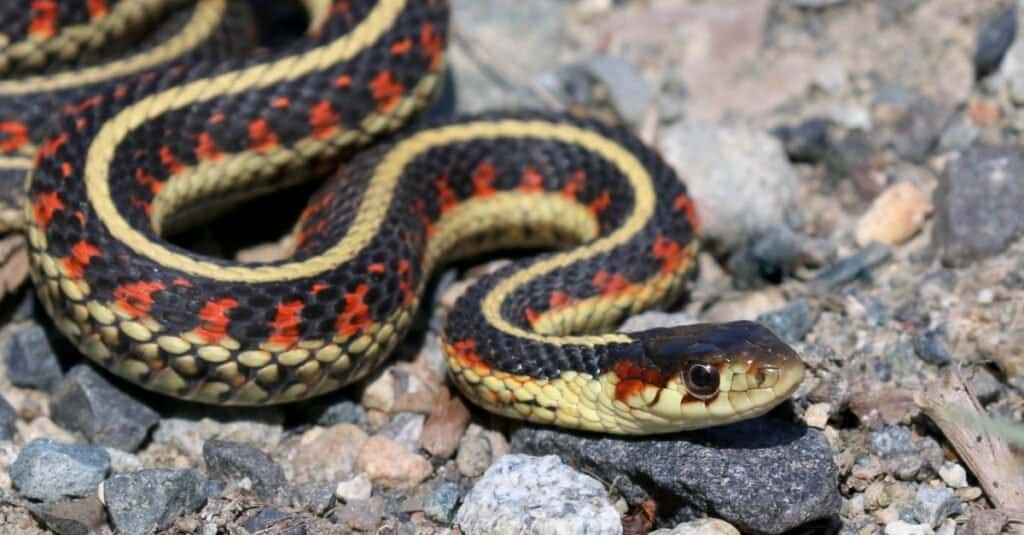
Garter snakes have large heads with small eyes.
©iStock.com/randimal
The final three snakes are garter snakes, and the common garter snake is a snake that is typically found to the east of the Continental Divide at elevations below 6,500 feet. These snakes are active between April and September and live near permanent water sources – often occurring near streams and ponds. Common garter snakes are 18 to 32 inches long and can be either black, brown, or green with yellow-colored stripes. Despite not being venomous, common garter snakes are slightly venomous towards their prey using a mild venom-like substance that they secrete in their saliva.
7. Western Terrestrial Garter Snake (Thamnophis elegans)
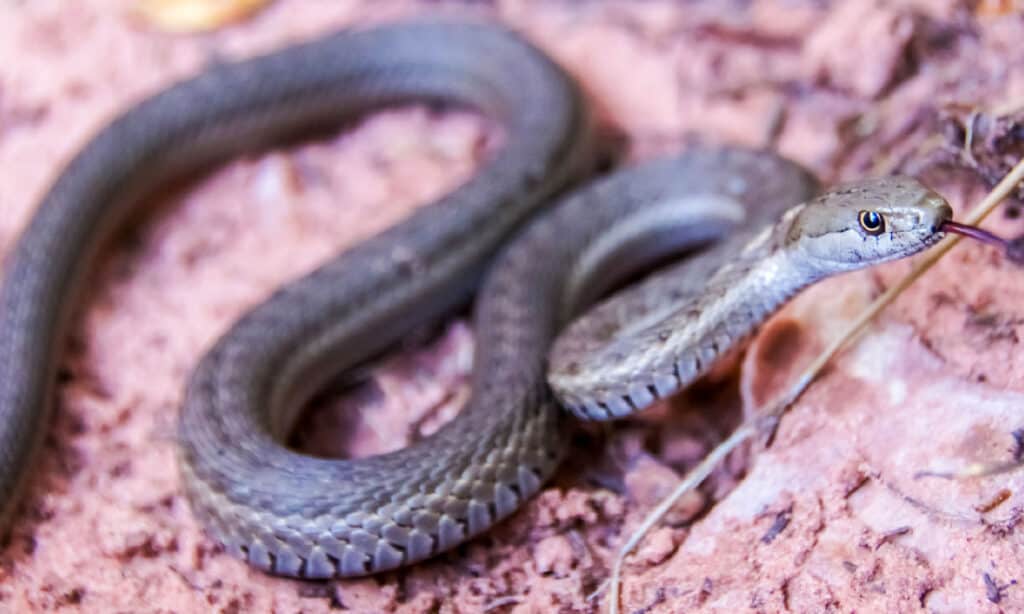
Western terrestrial garter snakes live in most habitats – including grasslands, forests, and even on mountains.
©iStock.com/yhelfman
Another garter snake is the western terrestrial garter snake that reaches 18 to 41 inches long. These snakes have varied appearances and can sometimes be entirely black. However, they usually have yellow, orange, or white stripes with red or black spots between them. Western terrestrial garter snakes live in most habitats – including grasslands, forests, and even on mountains up to 13,000 feet high. Like the common garter snake, these snakes have mildly venomous saliva. Although they are not particularly dangerous, a bite from these snakes can cause mild itching and swelling in the affected area.
8. Plains Garter Snake (Thamnophis radix)

Plains garter snakes mainly occur in the eastern region of Wyoming.
©Alyssa Metro/Shutterstock.com
The final black snake in Wyoming is the plains garter snake which is a slender-bodied snake of around 18 to 36 inches long. Plains garter snakes are typically black, greenish-grey, or brown with either orange or yellow stripes. They can be distinguished from other garter snakes as they have vertical black lines on their lips. Plains garter snakes are not venomous or dangerous to humans. Their main diet consists of small amphibians, slugs, and earthworms, but they also prey on some small mammals and birds. Plains garter snakes mainly occur in the eastern region of the state in grasslands and prairies near a permanent source of water. Plains garter snakes are known to be one of the most cold-tolerant snakes and can usually be seen basking in the sun, even on warm winter afternoons.
Up Next:
- Discover the 2 Types of Rattlesnakes in Wyoming
- 15 Snakes in Wyoming
- Discover the 7 Largest Animals in Wyoming, and Where You’ll Find Them
The photo featured at the top of this post is © Colby Hess/Shutterstock.com
Discover the "Monster" Snake 5X Bigger than an Anaconda
Every day A-Z Animals sends out some of the most incredible facts in the world from our free newsletter. Want to discover the 10 most beautiful snakes in the world, a "snake island" where you're never more than 3 feet from danger, or a "monster" snake 5X larger than an anaconda? Then sign up right now and you'll start receiving our daily newsletter absolutely free.
Sources
- Wyoming Game & Fish Department (1970) wgfd.wyo.gov/WGFD/media/content/PDF/Habitat/SWAP/Reptiles/Desert-Striped-Whipsnake.pdf
- Wyoming Game & Fish Department (1970) wgfd.wyo.gov/WGFD/media/content/PDF/Habitat/SWAP/Reptiles/Plains-Gartersnake.pdf
- Wyoming Game & Fish Department (1970) wgfd.wyo.gov/WGFD/media/content/PDF/Habitat/SWAP/Reptiles/Great-Basin-Gophersnake.pdf
- Wyoming Game & Fish Department (1970) wgfd.wyo.gov/WGFD/media/content/PDF/Habitat/SWAP/Reptiles/Black-Hills-Red-Bellied-Snake.pdf
- Wyoming Game & Fish Department (1970) wgfd.wyo.gov/WGFD/media/content/PDF/Habitat/SWAP/Reptiles/Plains-Black-headed-Snake.pdf
Thank you for reading! Have some feedback for us? Contact the AZ Animals editorial team.






